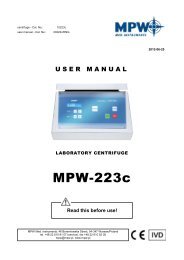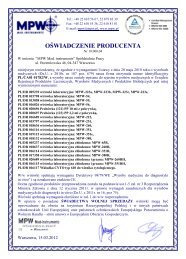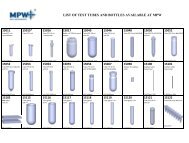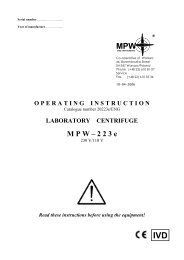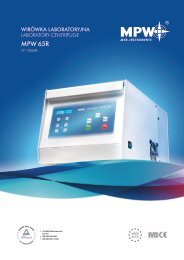download - MPW MED. INSTRUMENTS Spółdzielnia Pracy
download - MPW MED. INSTRUMENTS Spółdzielnia Pracy
download - MPW MED. INSTRUMENTS Spółdzielnia Pracy
You also want an ePaper? Increase the reach of your titles
YUMPU automatically turns print PDFs into web optimized ePapers that Google loves.
Serial number ...............…………....<br />
Production year ................................<br />
<strong>MPW</strong><br />
<strong>MED</strong>. <strong>INSTRUMENTS</strong><br />
®<br />
Co-operative of Workers<br />
46, Boremlowska Street<br />
04-347 Warsaw/Poland<br />
Phone: (+48 22) 610 81 07 Service<br />
Fax: (+48 22) 610 55 36<br />
13-03-2006<br />
O P E R A T I N G I N S T R U C T I O N<br />
Catalogue number 20065R/ENG<br />
REFRIGERATED LABORATORY CENTRIFUGE<br />
<strong>MPW</strong> – 65R<br />
230 V/110 V<br />
Read these instructions before using the equipment!<br />
IVD
1. Intended application.<br />
2. Technical data.<br />
2.1. Equipment.<br />
2.1.1. Basic equipment.<br />
2.1.2. Additional equipment.<br />
2.2. Materials used in operation.<br />
3. Installation.<br />
3.1. Unpacking the centrifuge.<br />
3.2. Location.<br />
3.3. Connecting to power supply.<br />
3.4. Fuses.<br />
4. Description of the centrifuge.<br />
4.1. General description.<br />
5. Operating safety conditions.<br />
5.1. Operators.<br />
5.2. Warranty period and service life.<br />
5.3. Storage time.<br />
5.4. Remarks for centrifuging.<br />
5.5. Safety precautions and risks.<br />
6. Using the centrifuge.<br />
6.1. Installing the rotor and equipment.<br />
6.2. Design and safety measures.<br />
6.3. Drive.<br />
6.4. Data setting and reading.<br />
6.5. Control system.<br />
6.6. Safety devices.<br />
6.6.1. Cover lock.<br />
6.6.2. Rest condition control.<br />
2<br />
Contents
7. Description of centrifuge control elements.<br />
7.1. Control panel.<br />
7.2. Switching on the centrifuge.<br />
7.2.1. Program selection.<br />
7.2.2. Centrifuging in continuous mode.<br />
7.2.3. Program start.<br />
7.2.4. Emergency stop.<br />
7.2.5. End of centrifugation.<br />
7.2.6. Programming.<br />
7.3. Mathematical relations.<br />
7.3.1. RCF – relative centripetal force.<br />
7.3.2. Nomogram of relations – rotational speed/centrifuging radius/RCF – figure 3.<br />
7.3.3. Maximum load.<br />
8. Cleaning, disinfection and maintenance.<br />
8.1. Cleaning the centrifuge.<br />
8.2. Cleaning the equipment.<br />
8.3. Sterilisation and disinfection of the centrifuging chamber and equipment.<br />
9. Failure states – service.<br />
9.1. Error control.<br />
9.2. Operating safety checks.<br />
9.3. Checks performed by the operator.<br />
10. Repair conditions.<br />
11. Manufacturer information.<br />
12. Distributor information.<br />
3
1. Intended application.<br />
4<br />
The <strong>MPW</strong>-65R centrifuge is a table top laboratory centrifuge with a cooled chamber. It is intended for<br />
in vitro diagnostic (IVD). The design of the centrifuge ensures ease of use, safe operation and a wide<br />
range of applications in laboratories performing medical, biochemical and other analyses. The<br />
centrifuge is intended for separating mixtures, suspensions and body fluids into their components of<br />
different density by the influence of centrifugal force. The centrifuge is not biologically tight and<br />
therefore when centrifuging preparations which require biological tightness special closed and sealed<br />
rotors should be used. Caustic, flammable and explosive substances must not be centrifuged.<br />
2. Technical data.<br />
Manufacturer: "<strong>MPW</strong> Med. instruments" Co-operative of Workers<br />
46 Boremlowska Sreet, 04-347 Warsaw/Poland<br />
Type: <strong>MPW</strong>-65R<br />
Power supply L1+N+PN V/Hz ±10 % 230 V 50/60 Hz, optionally 110 V 50/60 Hz<br />
Max power consumption 550 W<br />
Speed 300 14000 rpm<br />
Max volume 79.2 ml<br />
Max acceleration 20160 x g<br />
Max kinetic energy 9850 Nm<br />
Time range 099 min., or work in continuous mode<br />
Temperature range -20 o +40 o C<br />
Acceleration 3 characteristics<br />
Deceleration (braking) 3 characteristics<br />
Coolant CFC and HCFC free R-507<br />
Radio interference level PN-EN-55011<br />
Noise level 56 dB<br />
Physical properties:<br />
Depth 564 mm<br />
Width 298 mm<br />
Height 280 mm<br />
Weight 35 kg<br />
Operating conditions: PN-EN-61010-1 p. 1.4.1.<br />
Ambient temperature +5 o +40 o C<br />
Relative humidity at ambient temperature 80 %<br />
Installation class II PN-EN 61010-1<br />
Pollution class 2 PN-EN 61010-1<br />
Protection zone 300 mm<br />
Statement of Conformity:<br />
The following machine is in accordance with the regulations of the EU Directive 98/79/EC and with<br />
the harmonized standards PN-EN 61010-1 and PN-EN 61010-2-020.<br />
2.1. Equipment.<br />
2.1.1. Basic equipment (included with each centrifuge).<br />
- 17664 set of clamps<br />
- 17099T rotor spanner<br />
- 17162 lock key<br />
- 17862 fuses WTA-T 6.3 A, 250 V for <strong>MPW</strong>-65R 230 V 50/60 Hz;<br />
- 17863 fuses WTA-T 10 A 250 V for <strong>MPW</strong>-65R 110V 50/60 Hz (optionally);<br />
- 17866 power cord 230 V;
- 17867 power cord 110 V (optionally);<br />
- 20065R/ENG Operating Instruction<br />
2.1.2. Additional equipment.<br />
Depending on the needs, the following equipment can be installed in the <strong>MPW</strong>-65R centrifuge:<br />
Cat.<br />
No.<br />
11731<br />
11732<br />
11733<br />
11734<br />
11735<br />
11738<br />
12480<br />
Rotor<br />
type<br />
Angle rotor HSL<br />
Angle rotor HSL<br />
Angle rotor HSL<br />
Angle rotor HSL<br />
Angle rotor HSL<br />
Angle rotor HSL<br />
Hematocrite rotor<br />
12730 Swing-out rotor HSL<br />
HSL – Hermetically Sealed Lid<br />
5<br />
Angle Rotor<br />
capacity<br />
45 o<br />
45 o<br />
45 o<br />
45 o<br />
45 o<br />
45 o<br />
13483 Hanger for 4 tubes 2.2/1.5 ml;<br />
14084 Round carrier 0.5 ml ( 10.8/8.0 mm);<br />
14126 Round carrier 0.4 ml ( 10.8/5.7 mm);<br />
14133 Round carrier 0.2 ml ( 10.8/6.2 mm);<br />
14134 Round carrier 0.2 ml ( 7.8/6.2 mm);<br />
24x2.2/1.5 ml<br />
36x2.2/1.5 ml<br />
36x0.5 ml<br />
4x8x0.2 ml PCR<br />
24x2.2 ml/filter<br />
18x2.2 ml/filter<br />
24 capillary tubes<br />
1.4x75 mm, 37µl<br />
24x2.2/1.5 ml<br />
15100 Capillary tubes heparined (1.4x75 mm, 37 µl);<br />
15123 Polypropylene test-tube 2.2 ml with cover ( 10.8x43 mm);<br />
15124 Polypropylene test-tube 0.4 ml ( 5.7x46 mm);<br />
15125 PCR test-tube 0.2 ml ( 6x21 mm);<br />
15127 Polypropylene test-tube 0.5 ml with cover ( 7.8x30 mm);<br />
15128 Polypropylene test-tube 1.5 ml with cover ( 10.8x39 mm);<br />
15130 PCR test-tube 8x0.2 ml ( 6x21 mm);<br />
16098 Stopper for capillary tubes;<br />
16135 Hematocrite reader.<br />
Max<br />
rpm<br />
14000<br />
14000<br />
14000<br />
14000<br />
14000<br />
14000<br />
13000<br />
14000<br />
RCF r = max r = min<br />
18187<br />
18187<br />
17968<br />
15339<br />
20160<br />
18187<br />
16900<br />
16000<br />
2.2. Materials used in operation.<br />
Only proprietary elements listed in the equipment list shall be used in the centrifuge as well as<br />
centrifuge test-tubes with suitable diameter, length and strength. The use of test-tubes made by other<br />
companies shall be consulted with the manufacturer of the centrifuge. The centrifuge shall be cleaned<br />
and disinfected with agents used normally in the health care sector, such as Aerodesina-2000,<br />
Lysoformin 3000, Malseptol, Malsept SF, Sanepidex, Cutasept F.<br />
3. Installation.<br />
3.1. Unpacking the centrifuge.<br />
Open the box. Take out the box containing equipment. Take out the centrifuge of the box. Keep the<br />
box and the packaging materials for later transport.<br />
3.2. Location.<br />
Almost entire energy supplied to the centrifuge is converted into heat and radiated to the environment.<br />
Therefore, it is important to ensure suitable ventilation. The ventilation ducts in the unit must be fully<br />
efficient. Apart from this, the centrifuge should not be placed near radiators and in direct sunlight. The<br />
table on which the centrifuge is placed should be stable and have a flat, levelled tabletop. A protection<br />
8.3<br />
8.3<br />
8.2<br />
7.0<br />
9.2<br />
8.3<br />
8.9<br />
7.3<br />
5.0<br />
4.0<br />
5.8<br />
6.2<br />
6.0<br />
5.0<br />
1.4<br />
3.4
6<br />
zone of at least 30 cm should be left around the centrifuge. In normal working conditions the ambient<br />
temperature should not fall below 15C or rise above 35C. When the centrifuge is moved from a cold<br />
location to a warm one, condensation will occur inside the unit. Before starting the centrifuge again, it<br />
is important to ensure enough time for drying (at least 4 hours).<br />
3.3. Connecting to power supply.<br />
The supply voltage specified on the rating plate must be the same as the mains voltage. Laboratory<br />
centrifuges manufactured by <strong>MPW</strong> Med. instruments belong to safety class I and are equipped with a<br />
three-core cable of 2.53.2 m length with a plug that is resistant to dynamic loads. The socket should<br />
have an earthing pin. It is recommended to install an emergency switch which should be placed away<br />
from the centrifuge near the exit from the room or outside the room. Supply voltage 230 V 50/60 Hz,<br />
optionally 110 V 50/60 Hz.<br />
3.4. Fuses.<br />
The centrifuge has standard protection with the WTA-T 6.3 A 250 V fuse for centrifuge supplied by<br />
230 V 50/60 Hz and WTA-T 10 A 250 V fuse for centrifuge supplied by 110 V 50/60 Hz.<br />
Protection fuse is located in the socket at the back of the centrifuge.<br />
4. Description of the centrifuge.<br />
4.1. General description.<br />
The new type <strong>MPW</strong>-65R laboratory centrifuge manufactured by <strong>MPW</strong> Med. instruments is equipped<br />
with a modern microprocessor-based controller, a very reliable and silent brushless asynchronous<br />
motor and accessories consistent with current requirements. An efficient cooling system is loaded with<br />
an environment friendly coolant which ensures fast cooling of rotors and preparations.<br />
5. Operating safety conditions.<br />
5.1. Operators.<br />
The <strong>MPW</strong>-65R laboratory centrifuge can be used by the laboratory staff after they have read the<br />
operating instructions.<br />
The operating instructions shall be always kept close to the centrifuge.<br />
The instructions must be always close at hand!!!<br />
5.2. Warranty period and service life.<br />
The warranty period for the <strong>MPW</strong>-65R centrifuge is at least 24 months.<br />
Principles are specified in guarantee certificate. The service life of the centrifuge specified by the<br />
manufacturer amounts to 10 years.<br />
After termination of guarantee period it is necessary to carry out annaul technical inspections of<br />
the centrifuge made by authorized service of manufacturer.<br />
The manufacturer reserves the right to make modifications at produced goods.<br />
5.3. Storage time.<br />
Storage period for not used centrifuge at maximum amounts to 1 year. After this period centrifuge<br />
must be inspected by authorized service.<br />
5.4. Practical remarks for centrifuging.<br />
1. Place the centrifuge in horizontal position on a rigid surface.<br />
2. Ensure safe location for placing the unit.<br />
3. Ensure at least 30 cm of free space around the centrifuge.<br />
4. Ensure sufficient ventilation.<br />
5. Install the rotor firmly on the motor shaft.<br />
6. Avoid lack of balance.<br />
7. Load opposite sockets with the same kind of equipment.
7<br />
8. Centrifuging test-tubes of different size.<br />
It is in principle possible to centrifuge test-tubes of different size at the same time.<br />
However, it is absolutely necessary to ensure that the opposite reduction pieces are of<br />
the same kind. The test-tubes shall not only be placed symmetrically, but also the<br />
containers shall be loaded equally. It is not allowed to load rotors and containers<br />
asymmetrically.<br />
9. Load all rotor sockets.<br />
10. Vessels shall be filled outside the centrifuge.<br />
11. Vessels shall be filled with liquid of the same weight to prevent imbalance of the<br />
centrifuge.<br />
12. Lubricate the pivot pins of the horizontal rotor.<br />
13. Use only good equipment.<br />
14. Prevent corrosion of the unit be performing thorough maintenance.<br />
15. Infectious materials shall only be kept in closed containers.<br />
16. Do not centrifuge explosive and flammable materials.<br />
17. Do not centrifuge substances which could react as a result of supplying the high energy<br />
during centrifuging.<br />
5.5. Safety precautions and risks.<br />
1. Before attempting to start the centrifuge read all chapters of these operating<br />
instructions carefully in order to ensure smooth operation and to avoid damage to the<br />
unit or its accessories.<br />
2. The centrifuge may be operated by the staff after they have become familiar with the<br />
operating instructions.<br />
3. The Centrifuge must not be transported with the rotor installed on the motor shaft.<br />
4. Use only original rotors, test-tubes and spare parts.<br />
5. In the case of malfunction contact the service of <strong>MPW</strong> Med. instruments or an<br />
authorised representative of the company.<br />
6. Do not switch the centrifuge on, if it has not been installed properly or if the rotor has<br />
not been fitted correctly.<br />
7. The centrifuge must not be operated in places in which explosion risk is present, since it<br />
does not have an explosion protected design.<br />
8. Do not centrifuge materials which in contact with air may form flammable or explosive<br />
mixtures.<br />
9. Do not centrifuge toxic pathological materials, if appropriate safety measures have not<br />
been taken (work in suitably adapted rooms, personal protection equipment). Always<br />
perform appropriate disinfection procedures, it the centrifuge or its accessories have<br />
been contaminated with hazardous substances.<br />
10. Never open the cover by hand (in emergency), when the rotor is still rotating.<br />
11. Do not exceed the load limit specified by the manufacturer.<br />
Rotors are intended for liquids with an average uniform density of 1.2 g/cm 3 or less<br />
when centrifuging at maximum speed. If liquids with a greater density are to be used, it<br />
is necessary to reduce the speed (see section 7.3.3 “Maximum loads”).<br />
12. Do not use rotors, containers or reducing pieces with traces of corrosion or other<br />
mechanical damage.<br />
13. Do not centrifuge highly corrosive substances, which may cause damage to materials<br />
and impair the mechanical properties of rotors, containers and reducing pieces.<br />
14. Do not use rotors and equipment not approved by the manufacturer.<br />
It is allowed to use commercially available plastic test-tubes, which have been approved<br />
by their manufacturer for use in laboratory centrifuges.<br />
Warning for using equipment not specified in the instructions.<br />
Breaking test-tubes may cause dangerous imbalance.<br />
15. Do not centrifuge rotors with removed or untightened covers.<br />
16. Do not lift or move the centrifuge during operation. Do not lean on the unit.
8<br />
17. Do not stay in the safety zone of 30 cm around the centrifuge and do not leave any<br />
objects, such as glass vessels, inside the zone.<br />
18. Do not put any objects on the centrifuge.<br />
6. Using the centrifuge.<br />
6.1. Installing the rotor and equipment.<br />
1. Connect the centrifuge to the power supply source (main switch at the right side of the unit).<br />
2. Open the cover of the centrifuge by pressing the COVER button.<br />
Before installing the rotor, check if the centrifuging chamber is free from contamination,<br />
such as dust or liquid residues which must be removed.<br />
3. Loosen the clamp on the motor shaft using the special spanner and install the rotor on the<br />
motor shaft by inserting it on the cone as far as it goes.<br />
4. Screw in the rotor fixing clamp screw (clockwise) and tighten it with the included spanner.<br />
5. Horizontal rotors must have containers in all sockets. Remember that each container pivots<br />
separately. Container hanger pins should be lubricated every now and then with universal<br />
grease.<br />
6. If the rotor is equipped with a cover, it must not be used without the cover. Rotor covers must<br />
be closed carefully. Rotor covers reduce the rotor resistance, ensure correct fitting of testtubes<br />
and air-tight sealing.<br />
7. Use only containers that are suitable for the selected rotor type – see section 1.2 Equipment.<br />
8. Fill the vessels outside the centrifuge.<br />
9. Install or screw covers onto the vessels and rotors (if applicable).<br />
10. If centrifuging in an angle rotor, the test-tubes (containers) must be filled correctly in order<br />
to avoid spillage.<br />
11. NOTE: The centrifuge is able to transfer small weight differences which occur when loading<br />
the rotors. However, it is recommended to balance the vessels exactly as far as possible, in<br />
order to ensure operation with minimum vibrations.<br />
12. In order to extend the service life of the rotor and the seals, rotors should be covered with<br />
surface care oil, while seals and threads should be covered with vaseline.<br />
13. In order to replace the rotor, loosen the clamp by untightening the screw by several turns.<br />
Hold the rotor with both hands on the opposite sides and take if off the drive shaft by pulling<br />
it upwards.<br />
6.2. Design and safety measures.<br />
The centrifuge has a self-supporting design. The casing is made of aluminium plate. The cover is<br />
installed by means of steel hinges and locked in the front by an electromagnetic lock, which prevents<br />
its opening during centrifuging. The centrifuging chamber cover is made of steel sheet. The<br />
centrifuging chamber is made of stainless steel.<br />
6.3. Drive.<br />
The drive consists of a induction motor without carbon brushes with a low noise level. The risk of<br />
contaminating the preparations with carbon dust has been eliminated.<br />
6.4. Data setting and reading.<br />
The data setting and reading unit is an hermetic keypad with easily accessible and clear operating<br />
elements. The easy-to-read indicators, which signal the operations being performed, facilitate the<br />
programming of the unit by the operator as well as recording the parameters and unit status.<br />
6.5. Control system.<br />
The microprocessor-based control system of the centrifuge makes it possible to set and execute the<br />
operating parameters, i.e.:<br />
- selection of centrifuging speed from 300 to 14000 rpm in 100 rpm increments or acceleration x g<br />
(RCF)<br />
- selection of centrifuging time from 1 to 99 minutes or work in continuous mode<br />
- selection of acceleration characteristics from 1 – fastest to 3 – slowest
- selection of deceleration (braking) characteristics from 1 – fastest to 3 – slowest<br />
- setting the cooling temperature<br />
- selection of short operating time (“SHORT”) up to programmed speed<br />
- selection of cooling operating mode without centrifuging (“FREEZE”)<br />
9<br />
6.6. Safety devices.<br />
Apart from passive safety devices and measures, the unit also has active safety devices and elements:<br />
6.6.1. Cover lock.<br />
The centrifuge can only be started, if the cover has been closed correctly. The cover can only be<br />
opened after the rotor has stopped. If the cover is opened in emergency during operation, the<br />
centrifuge will be switched off immediately and the rotor will be braked until it stops completely.<br />
When the cover is open, the drive is completely disconnected from the power supply source, which<br />
makes it impossible to start the centrifuge.<br />
Releasing the cover in case of failure<br />
In the case of, for example, power supply outage it is possible to open the cover manually. There is a<br />
small hole on the right hand side of the casing. Insert a screwdriver or a wire ( 2) into the hole and<br />
press to release the cover.<br />
NOTE! The cover can only be unlocked and opened, when the rotor is at rest.<br />
6.6.2. Rest condition control.<br />
This condition is controlled by the microprocessor which recognises and signals the rest condition<br />
before the cover can be opened.<br />
7. Description of centrifuge control elements.<br />
Power supply is switched on and off with the switch at the right side of the centrifuge. All centrifuge<br />
settings are made by means of the control panel. The control panel has control buttons, displays and<br />
signalling LEDs.<br />
7.1. Control panel.<br />
The operation of the centrifuge is controlled by means of the control panel located on the front wall of<br />
the casing. The control panel contains the following elements:<br />
- Display<br />
Top field of the display<br />
- S: 5 digits (rpm) or RC: 5 digits (acceleration x g)<br />
-<br />
o C: + or - sign and two digits: temperature setting or temperature inside the centrifuging<br />
chamber during operation<br />
Bottom field of the display<br />
- T: 2 digits minutes 2 digits seconds, or dashes for centrifuging in continuous mode<br />
- ⋰ broken right slash signalling the acceleration characteristics or<br />
- ⋱ broken left slash signalling the deceleration characteristics<br />
- 1 digit 1, 2, 3 – indicating number of the rotor acceleration or deceleration characteristics<br />
- letter S indicating that the motor is not rotating or dash – indicating that the motor is<br />
working<br />
- dot • indicating closed cover or letter O indicating open cover.<br />
The equality sign (appearing instead of the colon) indicates that it is possible to change the parameter.<br />
button - down arrow is used for decreasing the parameter being set,<br />
button - up arrow is used for increasing the parameter being set,
10<br />
button - setting the centrifuging speed or the acceleration, when pressed again,<br />
button - setting the temperature,<br />
button - setting the centrifuging time from 1 to 99 min., or continuous work,<br />
button - setting the rotor acceleration characteristics or the deceleration<br />
characteristics, when pressed again,<br />
button is used for:<br />
- starting the centrifuging program with the parameters that are currently shown on the<br />
display,<br />
- the LED is blinking – the rotor is rotating,<br />
- the LED is switched off – the rotor is not rotating,<br />
button is used for:<br />
- stopping the centrifuging program at any stage and braking the rotor,<br />
- storing the parameters that have been set,<br />
button is used for opening the cover, switching on and off the cooling function<br />
without centrifugation,<br />
button is used for selection of short operating up to programmed speed,<br />
button is used for:<br />
- switching the cooling on and off without centrifugation,<br />
- when the cooling is switched on the LED is blinking during centrifugation and lightening<br />
constant when the rotor is not rotating,<br />
SOUND SIGNAL is used for defining the centrifuge status:<br />
- 1 short signal – push button function acceptance,<br />
- 2 short signals – push button function unacceptable,<br />
- 4 short signals – end of centrifugation,<br />
- 5 short signals – end of autotesting after switching on the centrifuge,<br />
- constant signal – overload of the controller<br />
7.2. Switching on the centrifuge.<br />
After the power supply has been switched on, the control system loads the latest program and displays<br />
the following information in the corresponding fields: centrifuging speed, centrifuging time,<br />
temperature and cover opening status. If the rotor inside the centrifuge is not rotating, it is possible to<br />
open the cover using the COVER button.
11<br />
If the rotor is stopped, it is indicated with the suitable symbol (letter S) in the corresponding field. If<br />
the symbol is not displayed, wait until the rotor has stopped and the symbol has appeared.<br />
7.2.1. Program selection.<br />
The control panel can store 1 user defined program. The program is accepted by pressing the STOP<br />
button.<br />
7.2.2. Centrifuging in continuous mode.<br />
Continuous centrifuging can be activated by set up dashes in the time mode instead of minutes and<br />
seconds, on the display. They are located between 99 and 1 min.<br />
7.2.3. Program START.<br />
After the program has been accepted and it has been checked that the rotor is installed, the centrifuge<br />
can be started by pressing the START button, provided that the cover is closed.<br />
7.2.4. Emergency STOP.<br />
During centrifuging it is possible to stop the process at any time and to brake the rotor by pressing the<br />
STOP button once.<br />
7.2.5. End of centrifugation.<br />
After the programmed centrifuging time has passed the braking of the rotor is started. At the end of the<br />
braking process the revolutions decrease slower in order to ensure soft settling of the rotor inserts.<br />
When the rotor has stopped, a sound signal can be heard and the S symbol is shown. After pressing the<br />
COVER button the cover opens and the O symbol is shown. In case when FREEZE button is pressed,<br />
before or during centrifugation, centrifuge will continue cooling when rotor stops.<br />
7.2.6. Programming.<br />
The programming mode is activated by pressing an appropriate button next to the display and setting<br />
the required parameter value to be entered or changed by means of the arrow buttons. The parameter<br />
values are confirmed by pressing the STOP button. Only one program can be stored.<br />
7.3. Mathematical relations.<br />
7.3.1. RCF – relative centripetal force.<br />
The RCF acceleration is the acceleration caused by the rotating movement of the rotor, which<br />
influences the product being tested and can be calculated from the following formula:<br />
RCF = 11.18 * r * (n/1000) 2<br />
RCF [x g]; r [cm]; n [rpm];<br />
The formula presented above can be used for calculating RCF min, RCF mean, or RCF max,<br />
depending on the distance of the particles of the product being tested from the centrifuging axis. If the<br />
RCF and the container bottom radius are given, it is possible to calculate the centrifuging speed to be<br />
set for the program. The settling time and the RCF should be determined experimentally for the<br />
product being tested.<br />
The electronic circuit automatically recalculates and displays the RCF value in 100 rpm increments.<br />
7.3.2. Nomogram of relations – rotational speed/centrifuging radius/RCF – figure 3<br />
7.3.3. Maximum load.<br />
In order to avoid overloading the rotor, the maximum load, indicated on each rotor, should be<br />
observed. The maximum allowable load is obtained when all test-tubes are filled with liquid with<br />
a density of 1.2 g/cm 3 .
12<br />
If the density of the liquid being centrifuged is greater than 1.2 g/cm 3 , the test-tubes can be only filled<br />
partially or the centrifuge speed should be reduced. The speed is calculated from the following<br />
formula:<br />
8. Cleaning, disinfection and maintenance.<br />
n allowed = n max *<br />
1 2 ,<br />
<br />
= specific gravity G<br />
cm 3<br />
<br />
<br />
<br />
<br />
<br />
n max - [max rpm]<br />
ATTENTION!!! Wear protective gloves when performing the work described below.<br />
8.1. Cleaning the centrifuge.<br />
Put on protective gloves before starting the cleaning and disinfection of the centrifuge. Use water with<br />
soap or other mild water-soluble cleaning agents for cleaning. Avoid corrosive and chemically<br />
aggressive agents. Do not use alkaline solutions, aggressive solvents or agents containing abrasive<br />
particles.<br />
8.2. Cleaning the equipment.<br />
Perform regular maintenance in order to ensure safe operation. Rotors, containers and reducing pieces<br />
must be resistant to continuous high stress from the gravitational field. Chemical reactions and erosion<br />
(combination of changing pressure and chemical reactions) can cause corrosion and damage to metals.<br />
The microcracks on the material surface become larger and reduce the strength of the material without<br />
visible symptoms. If surface damage, cracks or other changes, including corrosion, are noticed, the<br />
affected part (rotor, container, etc.) should be replaced. The rotor, including its fixing screw, the<br />
containers and the reducing pieces must be cleaned at regular intervals to prevent corrosion.<br />
The equipment should be cleaned outside of the centrifuge at least once a week or, even better, after<br />
each use. The parts should be then dried with a soft cloth or inside a chamber drier at 50 C.<br />
It is particularly the aluminium parts that are affected by corrosion. For cleaning these parts use a very<br />
neutral agent with pH 68. Do not use alkaline agents with pH above 8. The service life will be<br />
extended in this way and the susceptibility to corrosion will be reduced.<br />
Thorough maintenance extends the service life and prevents premature damage to the rotor. Corrosion<br />
and damage caused by insufficient maintenance cannot be the basis of any claims made to the<br />
manufacturer.<br />
8.3. Sterilisation and disinfection of the centrifuging chamber and equipment.<br />
All standard disinfecting agents can be used. The centrifuge and the equipment are made of different<br />
materials, which should be taken into account. Consider the temperature resistance of different<br />
materials when using steam for sterilisation. It should be mentioned that air-tight containers should be<br />
used for centrifuging, for example, infectious materials in order to prevent them from penetrating the<br />
centrifuge. Containers and rotors can be autoclaved at 121 o -124 o C for 15 minutes at 215 kPa. The<br />
centrifuge shall be disinfected with disinfecting agents used normally in the health care sector, (for<br />
examples look at & 2.2.). The user is responsible for disinfecting the centrifuge properly, if a<br />
dangerous material has been spilled outside or inside the unit. Always wear protective gloves<br />
when performing the work described above.
13<br />
9. Failure states – service.<br />
9.1. Error control.<br />
Most errors can be reset by switching off the centrifuge and switching it on again. After the centrifuge<br />
has been switched on, the parameters of the latest program should appear and a sound signal<br />
consisting of four consecutive beeps should be heard. In the case of a short power outage the<br />
centrifuge will complete the centrifuging cycle.<br />
Please find below the most frequent faults and their repair methods.<br />
1. Lack of display and buzzer sound: Remedies:<br />
Is mains socket live? Check power supply.<br />
Is supply cable plugged into mains? Plug correctly supply cable.<br />
Is input fuse good? Replace input fuse (rated data on rating plate).<br />
If it is burned again call service.<br />
Is master switch switched ON? Switch ON power supply.<br />
The above was checked and still there is no<br />
display active and no buzzer sound.<br />
Call service.<br />
2. Centrifuge does not start Remedies<br />
START key pushing does not generate reaction<br />
or single tone only.<br />
Rotor stopping symbol S is not displayed yet<br />
Wait till rotor stops and the rotor stopping<br />
symbol is displayed<br />
Cover opening symbol O is displayed Close cover. S symbol that means stop and<br />
symbol – closed cover should be displayed.<br />
LED STATUS diode is blinking: Centrifugation cycle is in progress, push STOP<br />
key or wait till cycle ends.<br />
Indications show a cycle in progress but the Switch power supply OFF/ON. If fault still<br />
motor does not start<br />
persists then call service.<br />
3. Programming function not active Remedies<br />
It is impossible to record parameter values to<br />
memory, last recorded program can not be<br />
recalled. Disturbances on displays possible too.<br />
Call service.<br />
4. Centrifuge starts but does not accelerate Remedies<br />
E symbol displayed after stopping. Drive Wait for 15 minutes and switch again after<br />
overload.<br />
opening and closing the cover. Turning of the<br />
P symbol displayed after pressing “START” rotor blocked. Switch off the centrifuge, check<br />
- constant signal.<br />
the rotor is not blocked. Close the cover and<br />
switch on the centrifuge.If no effects call servis.<br />
5. One can not open the cover Remedies<br />
Rotor stopping S symbol is not displayed yet, Rotor is still rotating. Wait for stopping of the<br />
after pushing cover opening key single tone is<br />
audible<br />
rotor and displaying of the S symbol.<br />
Nothing is displayed Check the centrifuge power supply.<br />
Rotor stopping S symbol is displayed, but cover<br />
cannot be opened<br />
Call service.
14<br />
9.2. Operating safety checks.<br />
From the point of view of operating safety, the centrifuge must be checked in its operating condition<br />
by an authorised service technician or a trained specialist at least one a year. More frequent checks<br />
may be required in the case of, for example, frequent imbalance or corrosive operating environment.<br />
The results of performed checks, repairs and tests must be recorded and stored. The operating<br />
instructions should be kept at the place of use of the centrifuge.<br />
9.3. Checks performed by the operator.<br />
The operator must make sure that those parts of the centrifuge that are important for its safety are not<br />
damaged.<br />
This regards in particular the following elements:<br />
1. Engine suspension system.<br />
2. Concentricity of the motor shaft.<br />
3. Fixing of the pivots in the rotor.<br />
4. Equipment of the centrifuge, and in particular structural changes, corrosion, initial cracks,<br />
wear of metal parts.<br />
5. Screwed connections.<br />
6. Checking the rotor unit.<br />
7. Checking the seals of the containers and rotors, if applicable.<br />
10. Repair conditions.<br />
The manufacturer grants the buyer a warranty on the conditions specified in the warranty card. The<br />
buyer loses the right to warranty repair if the unit is used contrary to the operating instructions, the<br />
unit is damaged by the user’s fault or the warranty card is lost. Repairs shall be performed by<br />
specialised service centres certified by <strong>MPW</strong>. Before sending the centrifuge to be repaired it must be<br />
disinfected.<br />
Information about authorised service centres is provided in the warranty card.<br />
Please contact your distributor or the manufacturer for information about servicing the unit abroad.<br />
11. Manufacturer information.<br />
Co-operative of Workers PL - 04-347 Warsaw/Poland<br />
46, Boremlowska Str.<br />
Phone: (+48 22) 610 56 21, 610 56 67,<br />
Operator: (+48 22) 610 50 14<br />
Fax: (+48 22) 610 55 36<br />
Service: (+48 22) 610 61 07<br />
INTERNET: http://www.mpw.pl<br />
E-mail: mpw@mpw.pl<br />
12. Distributor information.<br />
YOUR DISTRIBUTOR:
6<br />
5<br />
4<br />
3<br />
2<br />
1<br />
15<br />
Figure 1 – General view<br />
1. Motor shaft<br />
2. Rotor<br />
3. Rotor cover<br />
4. Clamp screw<br />
5. Control panel<br />
6. Cover of the<br />
centrifuge
pm<br />
Centrifuging time<br />
Acceleration x g<br />
Parameter change<br />
17<br />
Figure 2 – Control panel<br />
DISPLAY<br />
Acceleration Characteristics No.<br />
Deceleration<br />
Temperature<br />
Cover open<br />
Rotor stopped<br />
Cover closed<br />
Motor working
A<br />
40<br />
35<br />
30<br />
29<br />
28<br />
27<br />
26<br />
25<br />
24<br />
23<br />
22<br />
21<br />
20<br />
19<br />
18<br />
16<br />
14<br />
12<br />
10<br />
9<br />
8<br />
7<br />
6<br />
5<br />
18<br />
Figure No. 3<br />
Centrifuging radius [cm]<br />
R.C.F. (x "g")<br />
50<br />
multiple of<br />
gravitational<br />
acceleration<br />
45<br />
17<br />
15<br />
13<br />
11<br />
Example of making use<br />
A=14,4 cm<br />
B=4600 r.p.m.<br />
C=3400 x g<br />
NOMOGRAM<br />
Formula used for calculation of this<br />
nomogram :<br />
2<br />
R.C.F.= 11,18 * r * (n/1000)<br />
where :<br />
R.C.F. - multiple of<br />
gravitational acceleration<br />
r - centrifuging radius (cm)<br />
n - rotational speed (r.p.m.)<br />
g - gravitational acceleration<br />
n 1000 *<br />
r<br />
of the nomogram:<br />
<br />
<br />
<br />
<br />
<br />
11,<br />
18<br />
RCF<br />
<br />
* <br />
<br />
RCF<br />
11, 18 * r<br />
n<br />
1000<br />
2 <br />
<br />
<br />
<br />
<br />
100000<br />
50000<br />
40000<br />
30000<br />
20000<br />
15000<br />
10000<br />
8000<br />
6000<br />
5000<br />
4000<br />
3000<br />
2400<br />
2000<br />
1500<br />
1200<br />
1000<br />
800<br />
600<br />
500<br />
400<br />
300<br />
200<br />
150<br />
120<br />
100<br />
80<br />
60<br />
50<br />
40<br />
30<br />
25<br />
20<br />
15<br />
10<br />
8<br />
6<br />
5<br />
4<br />
3<br />
C<br />
B<br />
[r.p.m]<br />
20000<br />
15000<br />
14000<br />
13000<br />
12000<br />
11000<br />
10000<br />
9000<br />
8000<br />
7000<br />
6000<br />
5000<br />
4500<br />
4000<br />
3500<br />
3000<br />
2500<br />
2000<br />
1500<br />
1400<br />
1300<br />
1200<br />
1100<br />
1000<br />
900<br />
800<br />
700<br />
600<br />
500<br />
400<br />
300<br />
200




